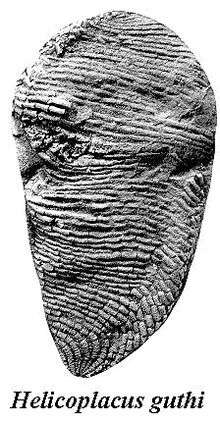Helicoplacus
| Helicoplacus Temporal range: Early Cambrian[1] | |
|---|---|
 | |
| Helicoplacus guthi[2] | |
| Scientific classification | |
| Kingdom: | Animalia |
| Phylum: | Echinodermata |
| Class: | †Helicoplacoidea |
| Genus: | Helicoplacus |
| Species | |
| |
 | |
Helicoplacus (often misspelled Helioplacus) is the earliest well-studied fossil echinoderm. Fossil plates are known from several regions. Complete specimens were found in Lower Cambrian strata of the White Mountains of California.
The animal was a cigar-shaped creature up to 7 centimetres (2.8 in) long that stood upright on one end. Unlike more typical echinoderms such as sea stars, Helicoplacus does not have fivefold symmetry. Instead, there is a spiral food groove on the outside along which food was moved to a mouth that is thought to be on the side. The respiratory system appears to be primitive. Although the animal does not look like a typical echinoderm, the plates are composed of the characteristic calcareous plates known as stereom that are common to all echinoderms. The ambulacrum is similar to that of the Edrioasteroidea; as a result, Helicoplacoidea may belong to Pelmatozoa.
Other contemporaneous echinoderms are known to have existed from their dissociated plates, but other than a few possible edrioasteroids, Helicoplacus is the earliest echinoderm that is well enough preserved to analyze its characteristics. One much earlier form called Arkarua has been hypothesized to be an ancestral echinoderm because of its fivefold symmetry. But Arkarua appears to lack both stereoms and a mouth.
Helicoplacoids seem to have existed for about 15 million years in the Lower Cambrian, around 525 million years ago.
Helicoplacoids are thought to have been suspension feeders living at moderate depths in highly oxygenated water with strong enough currents to ensure a steady food supply. They are typically found in greenish shales and are rarely found in shallow water sandstones and limestones. The helically spiraling rows of plates radiating from the base, which in life probably was anchored in the muddy substrate.[3]
References
- 1 2 Douglas, Palmer; et al. (2009). Prehistoric Life: The Definitive Visual History of Life on Earth (1st American ed.). New York: Dorling Kindersley. p. 72. ISBN 978-0-7566-5573-0.
- ↑ Durham, J.W., & Caster, K. E.; Caster, KE (17 May 1963). "Helicoplacoidea: A New Class of Echinoderms". Science 140 (3568): 820–822. doi:10.1126/science.140.3568.820. PMID 17746435.
- ↑ http://www.usna.edu/Users/oceano/pguth/website/pl00001.htm
See also
External links
- Pictures of 'Helicoplacus' can be found at http://www.usna.edu/Users/oceano/pguth/website/pl00001.htm